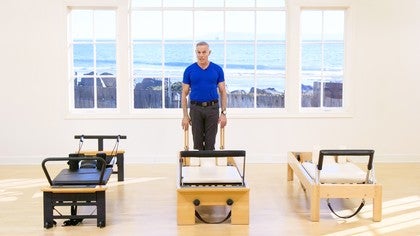Reformer Springs
Kevin Bowen
Workshop 2563
Watch this Workshop

Kevin Bowen
Hi Hugo - it is quite difficult to assign weight to springs as they vary greatly by manufacturer and spring producer. The manufacturer would need to have the company producing the springs assign value (weight) after the springs are produced. Further the springs all of arcs of resistance during their extension that also vary. Some springs start out heavier and become lighter resistance as they are stretched, while others start out light and become heavier at the end of the extension. You could try contacting the manufacturer of the equipment you use to see if they have values assigned. Further the tolerances on the springs during the duplication process (when a new batch is ordered) is +/- 10%. Meaning that if the original spring was calculated at +7% of the original spring weight and a new batch of springs produced as a replacement is measured to be -6%, then it is within acceptable manufacturing tolerances, but there is a difference of 13% tolerance between the old and the new.
5 years ago
Hi Kevin. I wonder if PA or you would address other differences...the wheels on a classical piece do not glide in the same way, so exercises feel different. The angle of pull of straps atbthe riser end is adjustable on some, not on others...how does it affect movement from bkt student and teacher perspective?
Short of being let loose in a warehouse full of all different equip from various manufacturers, it is difficult to know and appreciate and apply those differences in a teaching environment.
Short of being let loose in a warehouse full of all different equip from various manufacturers, it is difficult to know and appreciate and apply those differences in a teaching environment.
5 years ago
HI Genevieve - yes there are many differences in the equipment with regards to wheels, ball bearings in the wheels, etc. AND, yes where the pulley is on a more traditional reformer is quite different than where it is on a new piece, especially those that have pulleys that are actually above the frame of the carriage. Perhaps at some point PA will add some additional videos on the equipment. Feel free to contact me directly for more information. Thanks for your feedback.
5 years ago
I have an aeropilates with 4 black cords. I recently bought 2 red cords and a yellow cord. I am thinking about arranging my cords so that I have one red, two black and one yellow. How would these cords correspond to the reformers
you use on the videos? I’m often confused as to how many cords I should be using. Thank you for a great video. I love this website!
5 years ago
Hi Gina - I am not sure if the red cord is being sold as heavier than the black cords. If it is then use two black cords for all exercises suggesting 2 springs. I am assuming that the yellow cord is the lightest - is that how it was sold to you?
5 years ago
Thank so much for responding, Kevin. The red cord is much thicker and is apparently about 1.5 times as strong as the black. The yellow is thinner and the lightest of the three. Thank you!
5 years ago
Hi,
I trained on balanced body, however have just brought a Peak Studio style reformer for an excellent price. I wondered if someone could compare the weight of the springs. For example if BB suggest 2reds and 1B what is the Peak equivalent? My peak reformer has 1 red (heavy) 2 yellow (medium) and 2 blue (light). The blue and yellow are the opposite way around to BB and the Peak blue does not feel as light as a BB yellow.
Many thanks
5 years ago
Great information! The more knowledge we have the better we can explain and help others. Time to buy some new springs!
4 years ago
41-50 of 58
You need to be a subscriber to post a comment.
Please Log In or Create an Account to start your free trial.






































